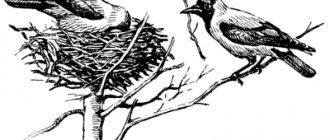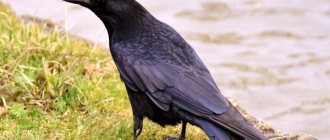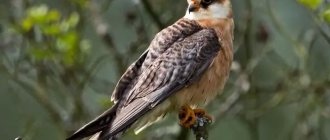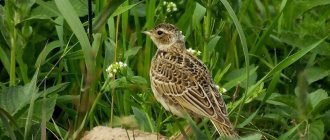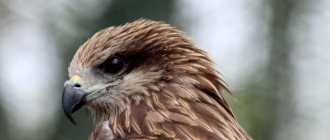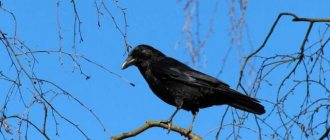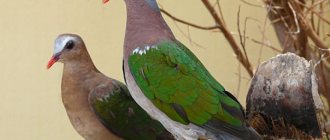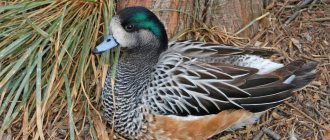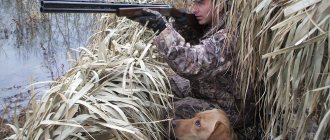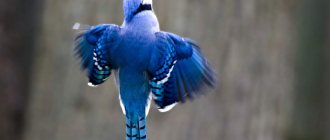- Wild animals
- >>
- Birds
If you turn on your imagination and mentally collect all the more or less beautiful birds for a beauty contest, then there is a high probability that the winner among them will be a blue magpie . And all because this bird has a very bright and extraordinary appearance, having smoky gray shades of plumage on the body, bright blue wings and tail, as well as a black cap on its head. All these characteristics make people think that the blue magpie is the very bird of happiness that not everyone can see.
Origin of the species and description
Photo: Blue Magpie
The blue magpie (Cyanopica cyana) is a fairly common bird that belongs to the Raven family (Corvidae), outwardly very similar to the common magpie (black and white), except for a slightly smaller size and a characteristic very impressive plumage color.
Its body length reaches 35 cm, its wingspan is 45 cm, and its weight is 76-100 grams. As already mentioned, in appearance and physique the blue magpie resembles the common magpie, except that its body, beak and legs are somewhat shorter.
Video: Blue Magpie
The plumage of the upper part of the bird's head, the back of the head and partly the area around the eyes is black. The upper chest and throat are painted white. The magpie's back is brownish or light beige with a slight smoky tint towards gray. The feathers on the wings and tail have a characteristic azure or bright blue color. The bird's tail is quite long - 19-20 cm. The beak, although short, is strong. The paws are also short and black.
Blue feathers on the wings and tail tend to shine and shimmer in the sun. In poor lighting (at dusk) or cloudy weather, the shine disappears, and the bird becomes gray and inconspicuous. In the wild, the blue magpie lives 10-12 years. In captivity, its life expectancy may be longer. The bird is easily tamed and trained.
Video "Pigeons-Peacocks"
A peacock dove can show off forty luxurious feathers to a friend at once. Seeking the attention of a dove, the male of this breed fluffs his tail, further increasing his resemblance to a peacock. Meanwhile, peacock pigeons cannot be called frivolous: they live in pairs, and the parents they make are simply excellent! After all, they hatch the eggs and take care of the chicks only together!
Breed standard
- Head: small in size, smooth feathers, without “hair”. When walking, he keeps his head tilted back. The beak is curved downwards, the neck is thin.
- Body: round, small.
- Tail: on a massive cushion, richly feathered, when open, forms a semicircle.
- Legs: medium size, unfeathered at the bottom, with red paws. When walking, peacock pigeons move on tiptoes, which makes their gait look very graceful.
In accordance with the standard, the following colors of plumage are allowed:
- Andalusian (dark blue color of the body plumage with a transition to black from the neck to the head; the tips of the wings are light);
- white;
- yellow (deep yellow, with a golden tint, without a gradient on the tailbone, silver-irridescent tint in the neck area);
- checkered;
- brown (chocolate);
- red (deep red, silver-iridescent in the neck area);
- cream (with a golden tint in the neck and wings);
- almond (deep almond; with a golden hue; with brown, white and black splashes);
- silver (silver with powder);
- blue (deep blue, blue-gray, blue with powder);
- black (black checkered, black-green).
Only very compelling reasons, including human activity, can force it to change. Small colonies of these birds can also be found in deciduous forests, in fields cultivated by farmers, olive groves, in the jungle, near villages.
Appearance and features
Photo: What a blue magpie looks like
The blue magpie is a bird slightly larger than a starling. At first glance, it very much resembles an ordinary medium-sized black and white magpie. In appearance it differs from its relative with a shiny black cap on its head, a gray or brownish body, a bright blue tail and wings. The bird's throat, cheeks, chest and tip of the tail are white, the belly is somewhat darker, with a brownish coating, the beak and paws are black.
The wings of the blue magpie have a completely typical structure for the raven family, but the color of their plumage is quite unusual - bright blue or azure, iridescent, shiny in the sun and dull, almost imperceptible in poor lighting. It is thanks to this feature that the blue magpie got its name. In many old fairy tales and legends, the blue magpie is referred to as the blue bird of happiness. Juvenile blue magpies acquire the color and appearance of adults at the age of 4-5 months.
Blue magpies are very sociable birds. They almost never fly alone, but always try to stay in large flocks and avoid people. In their habits, habits and character, they are very similar to ordinary magpies - cautious, intelligent, which, however, does not prevent them from sometimes showing curiosity.
Relationships with people[edit]
Taiwan blue magpies have attacked people to protect their nests. [12] [14] Taiwan blue magpies are sometimes captured illegally by people, but the number of such cases appears to have decreased. [15]
In the 2007 National Bird Vote Campaign conducted by the Taiwan International Birding Association, more than 1 million votes were cast from 53 countries. [16] [ further explanation required
] The Taiwan Blue Magpie defeated the Mikado Pheasant in the vote, but the vote was not officially accepted.
In 2022, China Airlines introduced the Taiwan Blue Magpie livery scheme on the Airbus A350. The aircraft was the 100th A350 produced by Airbus. [17]
The AIDC XAT-5 Blue Magpie is a modern jet trainer named after the blue magpie of Taiwan. [18]
Where does the blue magpie live?
Photo: Blue Magpie in Russia
Blue magpies live throughout almost all of Southeast Asia. The total area of the range is about 10 million square meters. km. The International Union of Ornithologists is inclined to distinguish 7 subspecies of these birds, which live in Mongolia (northeast) and 7 provinces of China, Japan and Korea, Manchuria, and Hong Kong. In Russia, populations of magpies are found in the Far East, in Transbaikalia (southern regions).
The eighth subspecies of blue magpies, Cyanopica cyana cooki, has a somewhat controversial classification and lives on the Iberian Peninsula (Portugal, Spain). In recent years, this bird has also been spotted in Germany.
In the last century, scientists believed that the magpie was brought to Europe by Portuguese sailors back in the 16th century. In 2000, the remains of these birds over 40 thousand years old were found on the island of Gibraltar. This find completely refuted the long-established opinion. In 2002, researchers from the Institute of Genetics at the University of Nottingham found genetic differences between blue magpie populations found in Asia and Europe.
Interesting fact: Before the Ice Age, blue magpies were very common in what is now Eurasia and were a single species.
Blue magpies prefer to live in forests, giving preference to areas with tall trees, but with the advent of civilization they can be found in gardens and parks, in eucalyptus thickets. In Europe, the bird settles in coniferous forests, oak forests, and olive groves.
Now you know where the blue magpie is found. Let's see what she eats.
Literature
- J.C. Alonso, R. Neves, R. Rufino: Cyanopica cyan
in W.J.M. Hagemeijer, M.J. Blair:The EBCC Atlas of European Breeding Birds – their distribution and abundance
, T&AD Poyser, London 1997, p. 674, ISBN 0-85661-091-7
- Zhang R., Song G., Qu Y., Alström P., Ramos R., Xing X., Ericson PGP, Fjeldså J., Wang H., Yang X., Kristin A., Shestopalov AM, Choe JC, Lei F.
Comparative phylogeography of two widespread magpies: Importance of habitat preference and breeding behavior on genetic structure in China (English) // Molecular Phylogenetics and Evolution: journal. - 2012. - Vol. 65. - P. 562-572. — DOI:10.1016/j.ympev.2012.07.011.
What does the blue magpie eat?
Photo: Blue Magpie in flight
Blue magpies are not too picky about their diet and are considered omnivorous birds. Most often they eat various berries, plant seeds, nuts, and acorns. One of the most favorite delicacies of birds is almonds, so they can be observed quite often in gardens or groves where many almond trees grow.
Also popular food for magpies are:
- various insects;
- worms;
- caterpillars;
- small rodents;
- amphibians.
Magpies hunt rodents and amphibians on the ground, and very deftly catch insects in the grass, on tree branches, or extract them from under the bark using their beak and clawed paws.
Interesting fact: The blue magpie, like its black-and-white relative, is characterized by theft. This means that birds can easily steal bait from a trap or other trap, as well as fish from a fisherman.
In winter, when there are very few seeds and edible animals in the forest, blue magpies can dig for a long time in garbage containers and landfills in search of food. There, their food can be discarded bread, cheese, pieces of fish and meat products. In especially difficult times, magpies do not disdain carrion. Also, magpies, along with other birds, can be frequent guests of feeders, which are arranged to help them survive the winter.
Nutrition
Magpies have no special dietary preferences. They are absolutely omnivorous birds. They feed on both small mammals and insects. The magpie is a bird that is prone to eating other people's chicks and eggs. It happens that she steals bones from dogs and cats. Often birds encircle fields and vegetable gardens and thereby spoil the harvest. They also feed on small rodents. Thanks to its powerful beak, the magpie tears its prey into pieces, holding the carcass itself with one paw. The beak also helps her break through eggs with ease. She will never go hungry thanks to her intelligence and dexterity.
Sources
- https://tropicbirds.ru/popugai/golubaya-soroka.html
- https://ornitoterapiya.ru/lyubimyj-popugaj/soroka-s-sinimi-krylyami.html
- https://vihuhol.ru/pernatye/golubaya-soroka.html
- https://tropicbirds.ru/vidy-popugaev/lazorevaya-soroka-foto.html
- https://ornitoterapiya.ru/drugoe/seraya-soroka.html
Features of character and lifestyle
Photo: Blue Magpie Bird
Blue magpies have a rather sonorous voice, so increased loudness is almost the norm for them. Birds lead a quieter and more secretive lifestyle only during nesting and feeding their offspring. Magpies prefer to live in small flocks, the number of which depends on the time of year. For example, from autumn to spring it is 20-25 pairs, and in summer - only 8-10 pairs. Moreover, the distance between their nests is very small - 120-150 meters, and some members of the flock can even live next door - on the same tree.
At the same time, pairs of blue magpies do not tend to communicate with each other too closely. However, in moments of danger, magpies are distinguished by their remarkable mutual assistance. Cases have been observed more than once when grouped birds, with hubbub and fighting, drove away a predator (hawk, wild cat, lynx) from the nest of their fellow flock members, almost pecking out its eyes.
People are no exception in this regard. When a person approaches their territory, magpies raise a cry, begin to circle above him and may even peck him on the head. Blue magpies lead both nomadic and sedentary lifestyles. In this regard, everything depends on the habitat, the availability of food and weather conditions. For example, in very cold winters they can migrate 200-300 km south.
Interesting fact: Due to their tendency to steal, blue magpies often get caught in traps while trying to remove the bait.
Interesting Facts
Having summarized everything that is known about the corvid family, of which the blue magpie is a representative, we can highlight the most remarkable facts characterizing this family:
- Any magpie has thieving tendencies. Man is always inclined to compare animals and birds with his own image and likeness. Here, rather, the inquisitive nature of the bird is manifested.
- Tamed birds of the corvid family are excellent at recognizing their owners by their faces. This can be confirmed, for example, by a zoo worker caring for these birds.
- To distract predators, magpies build several nests. For masonry, one is chosen - the safest.
- Well-organized, collective protection of nests. The first bird to notice the danger warns the others. The entire group furiously attacks the enemy.
- Magpies are caretakers of large animals. Large animals willingly allow birds to sit on their bodies to clean the skin of small parasites.
- Omnivorous. Their diet includes both plant and animal foods. They always, unlike squirrels, find food hidden in reserve.
- As a rule, a male and a female create a pair on a permanent basis.
- Although, after a month, the chicks begin to fly, the parents continue to obtain food for them over the next 15-20 days.
What is the situation with the population of these birds now? In other words, is the blue magpie in the red book or not? The question is not as simple as it might seem. In 1963, the International Union for Conservation of Nature released the first version of the red book. But, of course, she could not absorb all the diversity of the world's fauna and flora.
Therefore, there are red books not only in different countries, but even in different regions. These books are for reference only. In the USSR, the Red Book appeared on March 12, 1974. Many are sure that scientists only list endangered species of fauna and flora in the Red Book. This is wrong. Here are the sections of the Red Book of Russia:
- Pages with black border. Extinct living organisms and plants.
- With red frame. Almost gone.
- With yellow frame. Rapidly declining species.
- With white frame. Rare species.
- With gray frame. Little-studied species.
- With green frame. Species that have been restored.
The section to which the blue magpie is assigned today is of interest. In the international red books of Russia and China, they are not among the birds circled in red. But this, of course, is not a reason to calm down.
After all, the main reason for the disappearance of animals and birds is the reckless behavior of people. Until recently, species of animals and birds that were successful in terms of numbers disappeared. Here they are:
— Elephant turtle. The last individual died in 2012;
— Spotted green pigeon. There is a stuffed bird in the Liverpool Museum;
— Black rhinoceros from Cameroon. As a species, it disappeared in 2011;
- Sea cow. Exterminated in the second half of the last century.
The list goes on. The creation of protected areas, reasonable environmental policies, and, most importantly, people’s awareness of their role in protecting the animal and plant world will help preserve the diversity of fauna and flora for future generations, including the wonderful bird - the blue magpie.
Social structure and reproduction
Photo: Pair of blue magpies
The mating season for blue magpies begins at the end of winter. Their mating dances usually take place either on the ground or on the lower branches of trees. At the same time, males gather in large groups, showing their presence with loud cries. During courtship, the male, fluffing his tail and wings, gallantly nodding his head, walks around the female, showing himself in all his glory and showing her his admiration.
Interesting fact: Magpies mate for life.
A married couple builds a nest together, using all available means:
- small dry branches;
- pine needles;
- dry grass;
- moss.
From the inside, birds insulate the nest with everything: down, animal hair, rags, small pieces of paper. Birds do not reuse their old nests, but always build new ones. Usually the nest is placed in the crown of a tree on a thick static branch at a height of 5-15, and the higher the better. Its depth is 8-10 cm, and its diameter is 25-30 cm.
Around the beginning of June, females lay eggs. One clutch of blue magpies usually contains 6-8 beige spotted eggs of irregular shape, the size of a quail or slightly larger. Females incubate them for 14-17 days, content with regular offerings from caring spouses. During this period, males also act as cleaners, carrying females’ feces away from the nests. The chicks hatch quite amicably. They are covered with dark down and their beaks are not yellow, like most chicks, but crimson-pink.
Interesting fact: Blue magpies feed their chicks 6 times an hour, or even more often.
The arrival of parents with food (small insects, caterpillars, worms, midges) is always greeted by the chicks with a joyful squeak. If even the slightest danger appears, then at a signal from the parents, the chicks quickly calm down. Chicks leave the nest at the age of 3-4 weeks. At first they fly very poorly because of their small wings and short tail. For this reason, the chicks remain near the nest for about two weeks, and their parents feed them all this time. At the age of 4-5 months, the young acquire adult coloration, but at first the chicks look somewhat darker than their adult comrades.
Links[edit]
- ^ a b BirdLife International (2016). » Urocissa caerulea » . IUCN Red List of Threatened Species
.
2016
: e.T22705793A94035903. DOI: 10.2305/IUCN.UK.2016-3.RLTS.T22705793A94035903.en. - Gill, F; D. Donsker, ed. (2016). "Ravens, Mudders and Birds of Paradise". IOC World Bird List (version 6.3)
. Retrieved August 18, 2016. - Gould, John (1862). "Descriptions of Sixteen New Species of Birds from the Island of Formosa, Collected by Robert Swinhoe, Esq., Her Majesty's Vice-Consul to Formosa". Proceedings of the Zoological Society of London
.
1862
: 282. - Swinhoe, Robert (October 1863). "The Ornithology of Formosa, or Taiwan". Ibis
.
British Ornithologists' Union. 5
(4): 384–386. DOI: 10.1111/j.1474-919X.1863.tb05739.x. - ^ abc "Taiwan blue magpie (Urocissa caerulea)". HBW Live
. Retrieved August 15, 2016. - ^ ab Madge, Steve (2010). Crows and jays. A&C Black. pp. 103–104. ISBN 978-1-40-813169-5.
- ^ abcdef "Urocissa caerulea Gould, 1863".臺灣生命大百科
(in Chinese). Retrieved August 11 +2016. - "長尾山娘". Wildlife Society
(in Chinese). Wildlife Society. Retrieved August 23, 2016. - "Formosan Magpie". Birds in Taiwan
. Taiwan International Poultry Association. Archived from the original on October 14, 2013. Retrieved August 11 +2016. - McKinnon, John; Phillips, Karen (2000). A Field Guide to the Birds of China. Oxford: Oxford University Press. paragraph 264. ISBN 978-0-19-854940-6.
- 台灣藍鵲的故事 - 食性 (in Chinese)
- ^ abc Hsu, Ching Y.; Severinghaus, L. Liu. ymsnp.gov.tw
(in Chinese). Retrieved August 12 +2016. - Xu, Jing-Yen. "保育專題 - 台灣藍鵲" (PDF).林務局自然保育網
(in Chinese). Retrieved August 27, 2016. - 邱惠恩 (May 29, 2014). "台灣藍鵲警戒心高是驅離、非攻擊" .台灣醒報
(in Chinese). Taipei. Retrieved August 25, 2016. - "Formosan blue magpie conservation efforts are bearing fruit". China Post
. Taipei, Taiwan. January 3, 2008. Retrieved August 21 +2016. - "Taiwan National Bird Voting Results". Bird watching in Taiwan
. Taiwan International Poultry Association. Retrieved August 9 +2016. - Bright, Craig. "China Airlines unveils second bird-themed A350 livery". businesstraveller.com
. Business traveler. Retrieved May 11, 2022. - JR Wu and Michael Perry, Damon Lin. "Taiwan to build 66 jet trainers by 2026 to boost defense". reuters.com
. Reuters. Retrieved May 9, 2022. - "保育類野生動物名錄修正規定" (pdf).林務局自然保育網
. Retrieved August 14, 2016. - "Blue Crisis". Construction and Planning Agency of the Ministry of Internal Affairs of the Republic of China (Taiwan). Retrieved August 13 +2016.
Natural enemies of blue magpies
Photo: What a blue magpie looks like
Blue magpies are quite cautious birds, but their innate tendency to steal often plays a cruel joke on them. The thing is that when trying to steal bait from a trap or trap set by hunters, birds themselves quite often become their victims.
In addition, a bird caught in a trap is an easy snack for a wild cat, lynx and other felines. Also, these predators can easily destroy the nests of magpies in order to feast on fresh eggs or small chicks. In flight, blue magpies can be hunted by hawks, eagles, bald eagles, buzzards, eagle owls, and large owls.
For chicks that have barely left the nest and have not yet learned to fly well, martens, weasels and large snakes (in the tropics) pose considerable danger. Due to their bright appearance and quick learning ability, blue magpies are a highly sought-after product in pet stores. Because of this, they are specially caught in large quantities and are often injured.
There are some advantages to life in captivity for blue magpies. So, for example, if in nature birds usually live 10-12 years, then in captivity their lifespan doubles. Only magpies won’t say whether they need such a comfortable, problem-free and well-fed life without the opportunity to spread their wings and fly wherever they want?
Status [edit]
The IUCN Red List of Threatened Species currently rates the species as Least Concern because it does not meet vulnerability criteria. It is assumed that population dynamics will be stable. [1] Due to its endemism, however, the blue magpie of Taiwan has been listed among other wild animals worthy of conservation
(Chinese: 其他應予保育之野生動物)[19] and protected by Taiwan's
Wildlife Conservation Law
(Chinese: 野生動物保育法).
A small population of red-billed blue magpies was introduced to Wuling Farm in Taichung County (now part of Taichung City). In 2007, three hybrid chicks were found in a nest in Taichung, being cared for by red-billed and Taiwanese magpies. This has caused some concern among conservationists, given the decline of Taiwanese hwamei due to the invasion of Chinese hwamei. However, Taiwan's Endemic Species Research Institute is working to control red-billed magpie populations by trapping individual birds and relocating their nests. [20]
